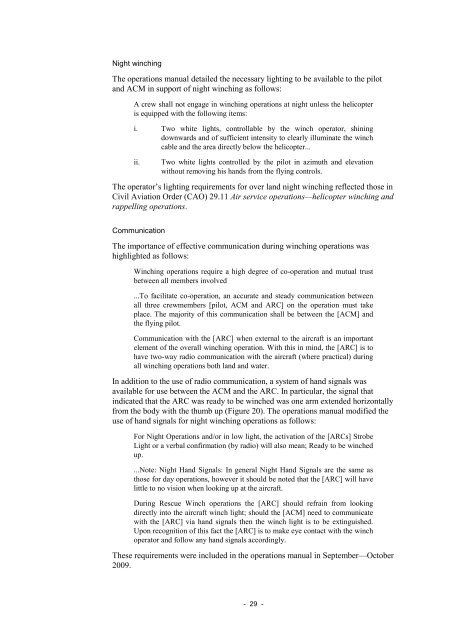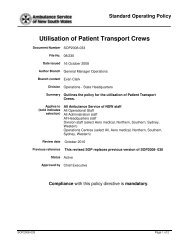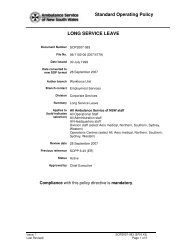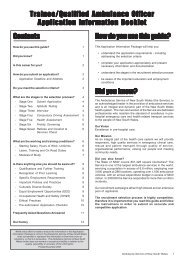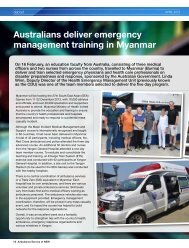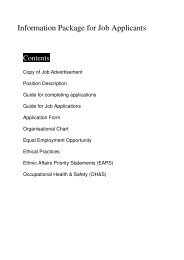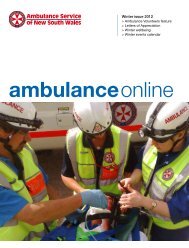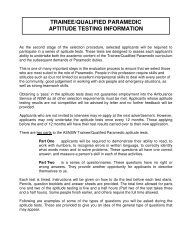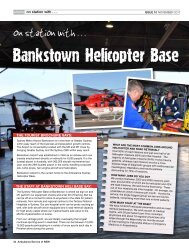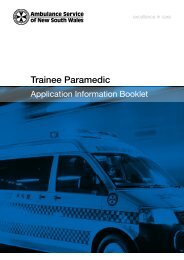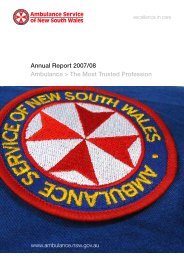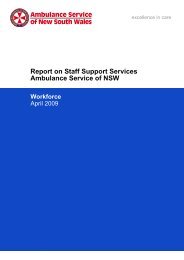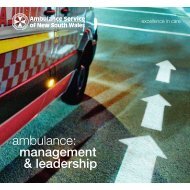atsb final report released 16 may 2013 - Ambulance Service of NSW
atsb final report released 16 may 2013 - Ambulance Service of NSW
atsb final report released 16 may 2013 - Ambulance Service of NSW
You also want an ePaper? Increase the reach of your titles
YUMPU automatically turns print PDFs into web optimized ePapers that Google loves.
Night winchingThe operations manual detailed the necessary lighting to be available to the pilotand ACM in support <strong>of</strong> night winching as follows:A crew shall not engage in winching operations at night unless the helicopteris equipped with the following items:i. Two white lights, controllable by the winch operator, shiningdownwards and <strong>of</strong> sufficient intensity to clearly illuminate the winchcable and the area directly below the helicopter...ii.Two white lights controlled by the pilot in azimuth and elevationwithout removing his hands from the flying controls.The operator’s lighting requirements for over land night winching reflected those inCivil Aviation Order (CAO) 29.11 Air service operations—helicopter winching andrappelling operations.CommunicationThe importance <strong>of</strong> effective communication during winching operations washighlighted as follows:Winching operations require a high degree <strong>of</strong> co-operation and mutual trustbetween all members involved...To facilitate co-operation, an accurate and steady communication betweenall three crewmembers [pilot, ACM and ARC] on the operation must takeplace. The majority <strong>of</strong> this communication shall be between the [ACM] andthe flying pilot.Communication with the [ARC] when external to the aircraft is an importantelement <strong>of</strong> the overall winching operation. With this in mind, the [ARC] is tohave two-way radio communication with the aircraft (where practical) duringall winching operations both land and water.In addition to the use <strong>of</strong> radio communication, a system <strong>of</strong> hand signals wasavailable for use between the ACM and the ARC. In particular, the signal thatindicated that the ARC was ready to be winched was one arm extended horizontallyfrom the body with the thumb up (Figure 20). The operations manual modified theuse <strong>of</strong> hand signals for night winching operations as follows:For Night Operations and/or in low light, the activation <strong>of</strong> the [ARCs] StrobeLight or a verbal confirmation (by radio) will also mean; Ready to be winchedup....Note: Night Hand Signals: In general Night Hand Signals are the same asthose for day operations, however it should be noted that the [ARC] will havelittle to no vision when looking up at the aircraft.During Rescue Winch operations the [ARC] should refrain from lookingdirectly into the aircraft winch light; should the [ACM] need to communicatewith the [ARC] via hand signals then the winch light is to be extinguished.Upon recognition <strong>of</strong> this fact the [ARC] is to make eye contact with the winchoperator and follow any hand signals accordingly.These requirements were included in the operations manual in September—October2009.- 29 -


